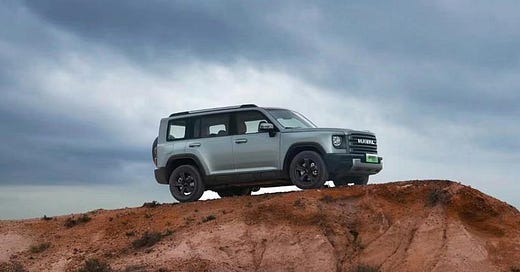Can Great Wall Motors Ever Catch Up to BYD After the Twenty Lost Years in the New Energy Race?
No one knows how long, but the journey will be tough.
Table of Contents
Haval, Building a Global SUV Expert
Tank: Leader in Domestic Off-Road Vehicles
WEY: Positioning as High-End Intelligent New Energy
Great Wall Motors' Forest Ecosystem
Pure Electric Technology: the SVOLT Ecosystem
Opportunity: New Energy Off-Road Vehicles
The Rise of Domestic Off-Road Vehicles Driving Market Growth
One Leading Brand and Several Strong Competitors
Sales Strategy: Dealership V.S. Direct Sales Model
Russia: Market Recovery and Opportunity for Chinese Brands
Thailand: Strong Presence of Japanese Brands, Growing Share of Chinese Brands
Australia: Steady Market Growth with High Share for Japanese and Korean Brands
Brazil: Market Dominated by Western Automakers, Chinese Brands Hold 6.5% Share in Q1 2024
Saudi Arabia: Market Growth with Dominance by Japanese and Korean Automakers
Introduction
During the Spring 2024 Tech Buzz China EV Trip, several investors and I found ourselves captivated by Great Wall Motors (GWM). This newsletter issue is dedicated to exploring this fascinating company in depth. By the way, if there are any China EV companies or topics you'd like us to cover, feel free to request them for future newsletters!
In today's edition, we take a comprehensive look at Great Wall Motors and its journey in the new energy sector over the past two decades. We'll delve into the company's "ONE GWM" strategy, examining its five key brands: Haval, Tank, WEY, Ora, and Great Wall Pickup. Our exploration continues with an in-depth analysis of GWM's Forest Ecosystem, highlighting the Hi4 Technology System, the SVOLT Ecosystem (which we had the chance to visit during the Spring EV Trip), the Coffee Intelligence, and its Hydrogen technology. Next, we assess the market opportunities for GWM and its sales strategy, focusing on new energy off-road vehicles and comparing its position against competitors like BYD. Finally, we discuss Great Wall Motors' global expansion and five major export markets.
Even more exciting, during the upcoming week-long Autumn 2024 Tech Buzz China EV Trip in October, we might be visiting Great Wall Motors and touring their factory. If you’re an investor eager to explore China’s booming electric vehicle ecosystem, join us now—only a few spots remain!
Freya Zhang, Research Editor
The Lost Twenty Years
Great Wall Motor (HKG: 2333, market cap 205.09B HKD), established in 1984 in Baoding, Hebei, is one of China's veteran car manufacturers. In the 1990s, it made its first profits from pickup trucks and later gained significant success in the SUV market with the Haval brand. The company's journey in new energy vehicles (NEVs) began early, around the start of the new millennium.
In 2001, China's Ministry of Science and Technology released a strategic plan for NEVs, emphasizing their future importance for energy security, air quality, and automotive industry competitiveness. This plan outlined a “three vertical and three horizontal” technology roadmap: hybrid, pure electric, and hydrogen fuel cell vehicles, along with power batteries, drive motors, and smart connectivity technologies. Despite these early plans, the global electric vehicle market was tiny, with only about 60,000 units sold worldwide by 2000. The first decade of the new century was a period of exploration for NEVs, and many companies, including Great Wall, were slow to shift focus.
During this time, GWM prioritized its successful fuel models like pickups and SUVs. In 2002, it launched the Safe SUV, which quickly became a top seller. Meanwhile, its new energy ventures saw little progress beyond strategic planning.
GWM’s research efforts began in 2003 with the establishment of its automotive research institute. It collaborated with institutions like Beihang University, Tsinghua University, and the China Automotive Technology and Research Center. However, the focus remained on fuel vehicles until a separate NEV research institute was created in 2006. In contrast, BYD (1211.HK, market cap 766.005B HKD) saw the potential early and began car manufacturing in 2003, showcasing three NEV concept cars at the 2004 Beijing Auto Show.
By 2008, NEVs were more visible, with 450 electric, 100 hybrid, and 20 fuel-cell vehicles used during the Beijing Olympics. This set the stage for the “Ten Cities, Thousand Vehicles” initiative in 2009, aiming to introduce 1,000 NEVs annually in ten cities for three years, supported by government subsidies. GWM followed the policy trends, making strides in NEV development.
At the 2008 Beijing Auto Show, GWM unveiled its first NEV concept cars, including the electric Ora (then called GWKULLA), the Great Wall Jingling EV, and a Haval hybrid. The Ora featured a 48V DC motor with a range of 140 km and a top speed of 65 km/h, resembling popular microcars of the time. As we mentioned in the Leapmotor piece, in China, this type of car is humorously referred to as "老头乐" (lǎo tóu lè), which roughly translates to "old man's joyride."
While BYD launched and sold its first plug-in hybrid, the F3DM, GWM struggled to bring its NEV concepts to market. Vehicles like the initial Ora and the Jingling EV never made it to production, leaving GWM in an exploratory phase for NEVs during this period. The pace of new energy vehicle development has rapidly increased, with players like BYD and Tesla capitalizing on favorable policies to make significant strides. In contrast, GWM chose to take a wait-and-see approach during this critical period.
In 2010, NEVs were designated as one of China's seven strategic emerging industries. In July, the Ministry of Finance and three other departments jointly issued a notice to launch a subsidy pilot program for private NEV purchases in five cities: Shanghai, Changchun, Shenzhen, Hangzhou, and Hefei. This marked the start of China’s financial support for the NEV industry. Despite this, the domestic NEV market was still in its infancy, with only 4,884 vehicles sold nationwide in 2010.
In June 2012, the State Council issued the "Energy Saving and New Energy Vehicle Industry Development Plan (2012-2020)," which increased financial and tax support. Central government funds were allocated to support technological innovation in NEVs and provide subsidies for public service demonstrations and private purchase pilots. Demonstration cities received funds to support the construction of charging facilities and establish battery recycling systems.
That year, GWM began researching battery cell products but did not fully commit to NEVs. In 2012, Great Wall Motots sold 625,000 vehicles, driven by the success of its Haval SUVs and flourishing in the fuel vehicle market, seemingly too occupied to focus on NEVs. In contrast, BYD launched the first model of its Dynasty series, the Qin, in 2012 and started expanding its NEV product line. Tesla also entered the Chinese market, signaling an impending industry transformation.
In 2014, China first proposed that developing NEVs was essential to becoming a strong automotive country. In July, the State Council issued guidelines to accelerate NEV promotion, offering tax exemptions for NEVs, clearly guiding the market. That year, new NEV manufacturers emerged, and sales reached about 80,000 units, nearly 15 times the sales of 2010.
Faced with these policy trends, GWM announced in 2015 plans to raise 16.8 billion yuan, primarily for NEVs. However, aside from plans and strategies, they did not introduce a competitive product. This hesitation might stem from the strategy of GWM’s leader, Wei Jianjun, who was skeptical about electric vehicles. In 2016, he stated that GWM would follow rather than lead in NEVs, citing China’s reliance on coal for electricity, making EVs not entirely clean.
BYD has taken a firm stance on new energy vehicles, proactively stopping the sale of gasoline cars to focus entirely on new energy development since 2022. They understand that buyers of domestic brand cars are highly price-sensitive, and even a small price difference of a few thousand yuan can influence purchasing decisions. Additionally, a year later, BYD split its sales network into the Dynasty Network and the Ocean Network. The Dynasty Network sells lower-priced models, while the Ocean Network focuses on higher-priced, newer models. This differentiation meets the needs of various consumers and enhances BYD's market presence. These strategic adjustments help BYD better respond to market changes and meet consumer demands.
GWM’s first pure electric car, the C30EV, was postponed until 2017. It featured a ternary lithium battery, a range of 200 km, a water-cooled permanent magnet synchronous motor with a maximum power of 90 kW (122 hp), and a top speed of 140 km/h. However, it failed to impress, with only 1,730 units sold in 2018, while BYD sold 247,800 NEVs that year.
In 2018, GWM finally established its first pure electric brand, Ora, ten years after the debut of Ora's first concept car. Over the past decade, GWM has missed many opportunities. This has made it difficult for them to compete in the now highly competitive NEV market. Ora, initially gained traction with small cars. However, the market for these microcars has since waned.
One reason is the low-profit margins of microcars are not conducive to long-term brand development. According to Ora, the Black Cat model incurs a net loss of over 10,000 yuan (about 1,400 USD) per unit, while its average selling price is only between 60,000 to 80,000 yuan (8,000-11,000 USD). An expert on Six Degrees Intelligence believes that although GWM's Ora brand was initially popular, it failed to keep up with a low-cost strategy, leading to models like the Black Cat and White Cat halting orders and losing customers. The company's inadequate cost control resulted in missed market opportunities.
The other reason is the strong competition from SAIC-GM-Wuling's Wuling Hongguang MINI EV, which has captured a significant market share. Statista shows in 2021, Wuling Hongguang Mini EV was the best-selling passenger BEV model in China, with sales approaching 400,000 units. This model was also the top seller among all passenger electric vehicle models in China that year.
GMW seemed more optimistic about hydrogen vehicles, starting research in 2015. In 2018, they established a hydrogen technology center and acquired full control of Shanghai Fuel Cell Vehicle Powertrain. In 2019, GWM founded FTXT Energy Technology Co. for its hydrogen business. In March 2021, GWM’s FTXT Energy unveiled its "Hydrogen Lemon Technology" system. Later that year, they launched a project with 100 hydrogen-powered heavy trucks.
Falling behind in the electric vehicle market, GWM was trying to find a new path in the hydrogen fuel cell sector. However, the NEV trend is unstoppable. 2022 became a crucial year for Great Wall Motors as they made significant strides in the new energy vehicle sector.







